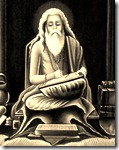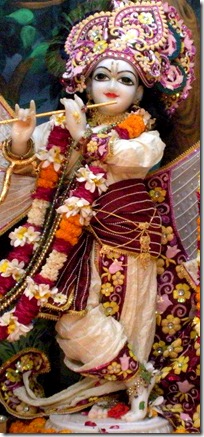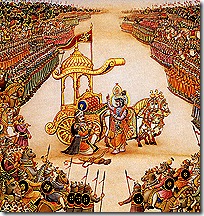 “The Vedic literatures composed by the omniscient Mahamuni Vyasadeva are evidence of all spiritual existence. Only through these revealed scriptures can all conditioned souls attain knowledge.” (Lord Chaitanya, Chaitanya Charitamrita, Madhya 20.353) “The Vedic literatures composed by the omniscient Mahamuni Vyasadeva are evidence of all spiritual existence. Only through these revealed scriptures can all conditioned souls attain knowledge.” (Lord Chaitanya, Chaitanya Charitamrita, Madhya 20.353)
“Did I make the most out of my life? What did my actions really amount to in the end? What was the purpose to my living? Where will I go from here?” These are the most important questions in life which the fortunate person will one day look to answer. The true saints of the earth, who were brave enough to share their sentiments with others regardless of the reception they received, thankfully have addressed these issues for us. In this sense they have looked out for everyone, including yourself, even if they have not met you personally.
How can someone answer an intimate question relating to my life if I have never met them? Ah, there are patterns to the human life cycle. Every person goes through birth, old age, disease and death. The living person hearing these facts obviously has not undergone death yet, but this doesn’t mean that it won’t happen eventually for them. The force of all-devouring time, known as kala in Sanskrit, has yet to lose. When it arrives, nothing can be done to send it away. No amount of begging or pleading can extend the predestined lifespan for the individual.
Since every living entity must die, we know that all the people of the past suffered death. They also went through the full cycle of birth to death, wherein if they had the fortune of maturing into adulthood they likely reached a position where they eventually pondered over the meaning of life and why they were put on the earth. These are valuable pieces of information to know because if someone else has already studied an issue that perplexes us today, we can consult their findings to see if anything tangible can be made of them. We can perhaps get an answer before we run any tests ourselves.
But which people should we consult? There are the mental speculators who have devised the scheme to enjoy life as much as possible. If you are destined to die, why worry at all about sin and good behavior? If the pious person meets the same fate as the miscreant, why the attention to following law codes? Shouldn’t every person just be out for themselves? Compete for resources and may the strongest person survive, no?
 The best combination is when you have an inquisitive person of a saintly character who meets the right set of information. That information must date back to the beginning of time and be presented through the mouth of a flawless person. The only being that cannot fall down is the Supreme Lord, who is thus known as Achyuta in the Vedic tradition. He has thousands of names which try to address His specific features, though there are too many glorious attributes to describe. The best combination is when you have an inquisitive person of a saintly character who meets the right set of information. That information must date back to the beginning of time and be presented through the mouth of a flawless person. The only being that cannot fall down is the Supreme Lord, who is thus known as Achyuta in the Vedic tradition. He has thousands of names which try to address His specific features, though there are too many glorious attributes to describe.
The Vedas are His talking points, His vital pieces of information passed on to the bewildered spirit souls unaware of their true position in the larger scheme. If you don’t know your defining position, which also represents your identity, how will you know how to act? A student acts by following the guidelines of the teacher, the worker the boss, and the citizen the government. In each case there is a specific identification leading the way.
But at the time of birth, these designations don’t exist; thus we know that they are temporary. They change throughout the course of one’s lifetime, and at death’s calling, the body itself is renounced. Therefore there must be more to life. There must be more to having an existence than struggling through temporary ups and downs that the animals experience as well.
The information originally passed on by God at the beginning of time has taken on a variety of forms with the passing of ages. In some forms brevity is the distinguishing factor, while in other forms there is more comprehensiveness attached. Thankfully for the world, the same speaker periodically comes to earth and repeats the information He originally presented at the beginning of time. Considering time and circumstance, He tailors His message accordingly.
 Arjuna’s chariot lay stationary on the battlefield. The war was about to begin, but the leading fighter for the Pandava side was hesitant. If you’re not ready to go full speed ahead, you won’t stand a chance in a violent conflict. Desire is as contributing a factor to victory as ability in the game itself. Arjuna had the ability. He could shoot arrows with the best of them. His marksmanship was so perfect that he once pierced the eye of a fish just by seeing its reflection in water. That feat earned him the hand of the beautiful queen Draupadi, but now the stakes were a little higher. A fight to the death would determine the control over a kingdom, one which rightfully belonged to Arjuna and his brothers. Arjuna’s chariot lay stationary on the battlefield. The war was about to begin, but the leading fighter for the Pandava side was hesitant. If you’re not ready to go full speed ahead, you won’t stand a chance in a violent conflict. Desire is as contributing a factor to victory as ability in the game itself. Arjuna had the ability. He could shoot arrows with the best of them. His marksmanship was so perfect that he once pierced the eye of a fish just by seeing its reflection in water. That feat earned him the hand of the beautiful queen Draupadi, but now the stakes were a little higher. A fight to the death would determine the control over a kingdom, one which rightfully belonged to Arjuna and his brothers.
To settle the doubts in His cousin and dear friend, Krishna stepped in and offered some sound words of advice. Ironically enough, the same lessons were imparted at the beginning of the creation. Krishna Himself revealed this cogent fact during the talk with Arjuna. He previously spoke these words to the sun-god, Vivasvan, who in turn passed it on to his son Manu, who then gave it to his son Ikshvaku. The saintly kings thus held on to the tradition of the essence of Vedic wisdom, but since the chain of disciplic succession had broken, Krishna was there to reinstate the tradition, to pass it on to another saintly fighter.
But the fighters weren’t the only ones familiar with this information. In fact, it was the saintly class of renounced mendicants who best understood this information and remained firmly convinced of its validity. You see, through sitting in their hermitages and steering clear of material attachment, the saints of the past had plenty of time to contemplate on both the meaning of life and the essence of the Vedas. They did all the heavy lifting for us, and the conclusions they produced were flawless.
They didn’t keep these secrets to themselves, though they didn’t openly proclaim them to every single person either. If I have a specific piece of information relevant to the field of computer science, I’m not going to walk into a doctor’s office and start sharing that with the doctor. They may or may not be interested in hearing what I have to say, but the office is not the proper venue. The constitutional position of the doctor’s office or the hospital is to heal sick patients.
 If the patients aren’t willing to take the medicine, then no amount of treatment can save them. In a similar manner, if the hearts and minds of the listeners are not attuned to learning about the meaning of life and the way to properly act, no amount of instruction will do them good. Ah, though qualified recipients are rare to find, the saints couldn’t keep all of this information bottled up. They documented their sense perceptions, their mental conclusions based on the original fact of God and His divine presence, into written form to be passed on to future generations. If the patients aren’t willing to take the medicine, then no amount of treatment can save them. In a similar manner, if the hearts and minds of the listeners are not attuned to learning about the meaning of life and the way to properly act, no amount of instruction will do them good. Ah, though qualified recipients are rare to find, the saints couldn’t keep all of this information bottled up. They documented their sense perceptions, their mental conclusions based on the original fact of God and His divine presence, into written form to be passed on to future generations.
So what was the conclusion they reached? The same one that Arjuna did, of course. The hesitant warrior, through heeding Krishna’s advice, threw away his doubts and decided to fight ahead. He was no longer concerned with victory or defeat or whether the friends and family fighting for the opposing side would continue to live. He followed through because Krishna asked him to. The relational link to the Supreme Lord is what serves as our guiding force. Knowledge of the link is the first step, and following through on the steps necessary to revive that link represent the next leap forward.
A life lived in devotional service, or bhakti-yoga, dispels all doubts as to the reason for existence. There is no regret at the time of death if much time was spent chanting, “Hare Krishna Hare Krishna, Krishna Krishna, Hare Hare, Hare Rama Hare Rama, Rama Rama, Hare Hare”, during one’s days on earth. The purpose to the existence is solved through devotional practices, as one tastes the sweet fruit of Krishna’s association. His name is as good as His personal self, and His activities are equally as representative of Him.
These names, forms, activities and attributes are passed on in the Vedic literature, and simply hearing about them from someone who follows the same mood of devotion as Arjuna can eliminate all doubts. The saints look out for us, often before we are even born. The spiritual masters of the Vaishnava tradition, who devote their thoughts, words and deeds to Vishnu, or Krishna, know what is best for every single person. They know the answers to problems before they are encountered, and because of this prescience their association is always the most wonderful boon in life.
In Closing:
At death’s call, your body about to quit,
Ponder your time on earth, was it worth it?
What did it all mean, what did I really do?
Life after death, is it real, can it be true?
Saints of the past on this did all the heavy lifting,
Their conclusions profound wisdom to mankind gifting.
Ultimate truth of devotion to Krishna they did reach,
How to find that same path to others they do teach.
Arjuna followed devotion and saints do the same,
Live a life devoted to God, chant always His name.
|
Search This Blog
Tuesday, May 1, 2012
Looking Out For You
Scientists identify brain circuitry associated with addictive, depressive behaviors
(Medical Xpress) -- Scientists at the UCSF-affiliated Gladstone Institutes have determined how specific circuitry in the brain controls not only body movement, but also motivation and learning, providing new insight into neurodegenerative disorders such as Parkinson’s disease — and psychiatric disorders such as addiction and depression.
Previously, researchers in the laboratory of Gladstone Investigator Anatol Kreitzer, PhD, discovered how an imbalance in the activity of a specific category of brain cells is linked to Parkinson’s.
Now, in a paper published online today in Nature Neuroscience, Kreitzer, who is also an assistant professor of physiology at UCSF, and his team used animal models to demonstrate that this imbalance may also contribute to psychiatric disorders. These findings also help explain the wide range of Parkinson’s symptoms — and mark an important step in finding new treatments for those who suffer from addiction or depression.
“The physical symptoms that affect people with Parkinson’s — including tremors and rigidity of movement — are caused by an imbalance between two types of medium spiny neurons in the brain,” said Kreitzer, whose lab studies how Parkinson’s disease affects brain functions. “In this paper we showed that psychiatric disorders — specifically addiction and depression —might be caused by this same neural imbalance.”
Normally, two types of medium spiny neurons, or MSNs, coordinate body movements. One type, called direct pathway MSNs (dMSNs), acts like a gas pedal. The other type, known as indirect pathway MSNs (iMSNs), acts as a brake. And while researchers have long known about the link between a chemical in the brain called dopamine and Parkinson’s, Gladstone researchers recently clarified that dopamine maintains the balance between these two MSN types.
But abnormal dopamine levels are implicated not only in Parkinson’s, but also in addiction and depression. Kreitzer and his team hypothesized that the same circuitry that controlled movement might also control the process of learning to repeat pleasurable experiences and avoid unpleasant ones—and that an imbalance in this process could lead to addictive or depressive behaviors.
Kreitzer and his team genetically modified two sets of mice so that they could control which specific type of MSN was activated. They placed mice one at a time in a box with two triggers — one that delivered a laser pulse to stimulate the neurons and one that did nothing. They then monitored which trigger each mouse preferred.
“The mice that had only dMSNs activated gravitated toward the laser trigger, pushing it again and again to get the stimulation — reminiscent of addictive behavior,” said Alexxai Kravitz, PhD, Gladstone postdoctoral fellow and a lead author of the paper. “But the mice that had only iMSNs activated did the opposite. Unlike their dMSN counterparts, the iMSN mice avoided the laser stimulation, which suggests that they found it unpleasant.” These findings reveal a precise relationship between the two MSN types and how behaviors are learned. They also show how an MSN imbalance can throw normal learning processes out of whack, potentially leading to addictive or depressive behavior.
“People with Parkinson’s disease often show signs of depression before the onset of significant movement problems, so it’s likely that the neural imbalance in Parkinson’s is also responsible for some behavioral changes associated with the disease,” said Kreitzer, who is also an assistant professor of physiology at UCSF.. “Future research could discover how MSNs are activated in those suffering from addiction or depression—and whether tweaking them could reduce their symptoms and improve their quality of life.
Graduate student Lynne Tye was also a lead author on this paper. Funding came from a variety of sources, including the W.M. Keck Foundation, the Pew Biomedical Scholars Program, the McKnight Foundation and the National Institutes of Health.
Gladstone is an independent and nonprofit biomedical-research organization dedicated to accelerating the pace of scientific discovery and innovation to prevent, treat and cure cardiovascular, viral and neurological diseases.
UCSF is a leading university dedicated to promoting health worldwide through advanced biomedical research, graduate-level education in the life sciences and health professions, and excellence in patient care.
Provided by University of California, San Francisco
"Scientists identify brain circuitry associated with addictive, depressive behaviors." April 30th, 2012. http://medicalxpress.com/news/2012-04-scientists-brain-circuitry-addictive-depressive.html
Posted by
Robert Karl Stonjek
Robert Karl Stonjek
Subscribe to:
Posts (Atom)